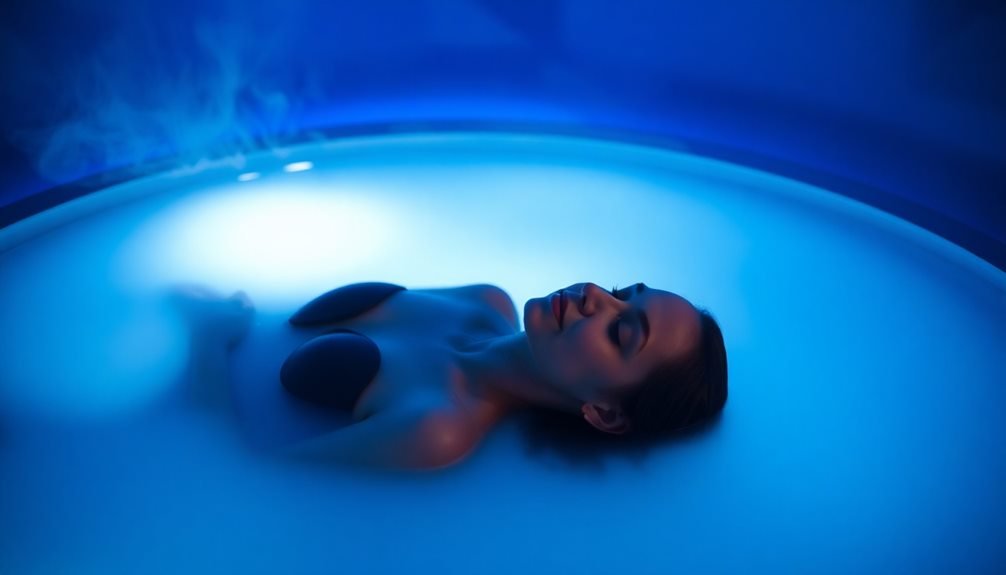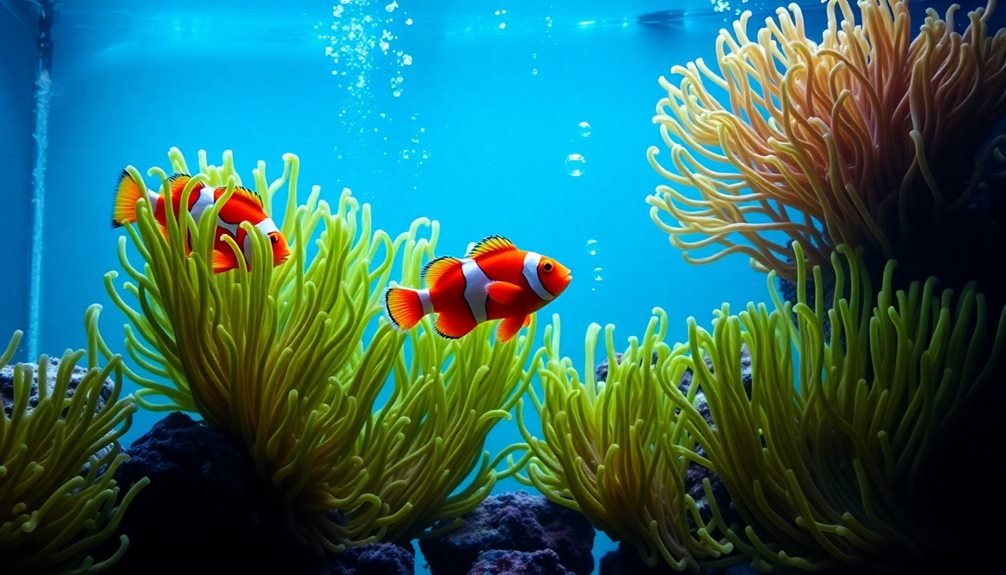Water-based activities offer powerful natural remedies for anxiety relief. You'll find peace through float therapy, where you can experience weightless relaxation in a sensory deprivation tank. Try gentle swimming with mindful breathing patterns to create a meditative rhythm, or practice beach walking meditation to sync your breath with crashing waves. Create a calming oasis with a water garden, soak in therapeutic hot springs, or collect smooth river rocks while practicing mindfulness. You can also reduce stress by watching an aquarium's peaceful inhabitants glide through blue-green waters. These seven water activities hold the key to transforming your anxious mind into a sanctuary of calm.
Float Therapy for Mental Peace

While many relaxation techniques focus on breathing or meditation, float therapy offers a unique approach to achieving mental peace through sensory deprivation. Inside a specially designed tank filled with body-temperature water and Epsom salt, you'll experience weightlessness as you float effortlessly on the surface. The high salt concentration makes sinking impossible, allowing your muscles to completely relax.
During your session, you'll find yourself in a quiet, dark environment that eliminates external stimuli. This absence of sensory input helps your brain shift from its usual beta waves to the calmer alpha and theta waves, similar to what you'd experience in deep meditation. Your body's stress hormones, particularly cortisol, begin to decrease while your brain releases mood-enhancing endorphins.
You can typically book sessions lasting 60 to 90 minutes, though some centers offer longer options. For ideal anxiety relief, consider scheduling regular sessions every two weeks.
The cumulative effects of float therapy include reduced blood pressure, improved sleep quality, and decreased anxiety symptoms. If you're new to floating, start with a 60-minute session to acclimate to the experience.
Gentle Pool Swimming Sessions
Practicing slow breathing while swimming laps can help you synchronize your movements with your breath, creating a meditative rhythm that calms your nervous system.
You'll find that mindful water movements, like gliding deliberately through the water with focused attention on each stroke, naturally lower stress levels and promote relaxation.
When you need a break, simply float on your back and let the water support your body, allowing tension to dissolve as you connect with the peaceful sensation of buoyancy.
Slow Breathing Lap Techniques
Swimming laps at a gentle pace sets up an ideal environment for combining physical movement with mindful breathing exercises. As you glide through the water, focus on establishing a steady breathing rhythm that complements your strokes. You'll want to inhale every four strokes and exhale slowly underwater, creating a meditation-like pattern that helps calm your nervous system.
Start with the basic freestyle stroke, breathing to your preferred side. Instead of rushing to complete laps, concentrate on making each movement deliberate and flowing. Count your strokes and breaths, maintaining a consistent tempo that feels comfortable and sustainable. You can modify this pattern by taking two breaths per lap if you're feeling anxious or need more air.
To enhance the calming effect, try bilateral breathing – alternating sides for air intake. This technique balances your body position and creates a more symmetrical swimming pattern.
When you feel tension building, pause at the pool's edge between laps, take three deep breaths, and reset your focus. Remember, the goal isn't speed or distance but rather finding your natural rhythm while staying present in the water.
Create Mindful Water Movements
Through gentle movements in the pool, you can develop a mindful swimming practice that transforms routine exercise into active meditation. Focus on each deliberate motion while maintaining awareness of how your body interacts with the water. Let the pool's natural resistance guide your movements as you practice mindfulness.
Start with slow, controlled movements in chest-deep water. Notice how the water feels against your skin, the temperature, and the gentle pressure surrounding your body. As you move, concentrate on the ripples you create and the sound of water flowing past your ears. This heightened awareness helps quiet racing thoughts and anchors you to the present moment.
- Try water walking meditation: Move slowly from one end of the pool to the other, feeling each step and the water's resistance against your legs.
- Practice mindful floating: Let yourself float on your back, focusing on your breath and the sensation of being supported by the water.
- Explore gentle arm sweeps: Stand in place and make slow, purposeful movements with your arms through the water, noting the sensation and resistance.
Keep your movements unhurried and intentional, allowing yourself to fully experience each moment in the water.
Float for Stress Release
Gentle floating sessions in a pool can greatly reduce stress levels by activating your body's natural relaxation response. As you float, your muscles release tension, your heart rate slows down, and your brain produces calming alpha waves. This state mimics deep meditation, allowing your body and mind to reset.
To begin floating, find a quiet pool area and use foam noodles or kickboards for support if needed. Lie back in the water, extending your arms and legs while keeping your face above the surface. Focus on your breathing – inhale for four counts, hold for four, then exhale for four. You'll notice the water gently supporting your body weight, creating a sensation of weightlessness.
Start with five-minute sessions and gradually increase to 15-20 minutes as you become more comfortable. If you're new to floating, practice during off-peak hours when the pool is less crowded.
You can enhance the experience by wearing earplugs to block out ambient noise and goggles to prevent chlorine irritation. Remember to maintain a comfortable water temperature between 83-86°F (28-30°C) for ideal relaxation.
Beach Walking Meditation

Along the sandy shoreline, beach walking meditation combines the therapeutic effects of water with mindful movement. As you stroll barefoot across the beach, you'll connect with nature while engaging your senses in a calming, anxiety-reducing practice. The rhythmic sound of waves, combined with the tactile sensation of sand between your toes, creates a natural environment for releasing tension.
To practice beach walking meditation effectively, focus on these key elements:
- Sync your breathing with your footsteps, taking slow, deliberate steps while maintaining awareness of each foot's contact with the sand.
- Let the sound of waves guide your pace, using their natural rhythm to help quiet racing thoughts and ground yourself in the present moment.
- Notice the varying textures beneath your feet – from wet, compact sand near the water to soft, dry sand further up the beach.
You don't need to walk far or fast. Instead, choose a stretch of beach that feels comfortable and walk at a pace that allows you to maintain mindful awareness.
The combination of gentle exercise, fresh air, and water's presence helps reduce stress hormones while promoting a sense of calm.
Soothing Water Garden Care
Creating and maintaining a water garden brings the calming presence of water right to your backyard, offering a more accessible alternative to beach visits. You'll find peace in the gentle sounds of trickling water and the meditative process of caring for aquatic plants.
Start small with a pre-formed pond liner or container water garden. Choose water plants like lotus, water lilies, or rushes that provide different textures and heights. The simple act of pruning dead leaves and cleaning filters can become your mindful ritual, helping you stay present and focused on the task at hand.
Make tending to your water garden a daily practice. Spend time checking water levels, removing debris, and observing the wildlife it attracts. You'll notice how dragonflies hover above the surface and birds stop by for a drink. These moments of connection with nature can greatly reduce anxiety levels.
Consider adding underwater lighting to extend your peaceful moments into the evening hours. You can sit beside your water garden after a stressful day, letting the rhythmic water sounds and subtle light reflections calm your racing thoughts.
Therapeutic Hot Springs Soaking

Natural hot springs offer one of nature's most potent remedies for anxiety, combining mineral-rich waters with therapeutic heat. When you immerse yourself in these geothermal pools, you'll experience both physical and mental benefits as the warm waters ease muscle tension and promote deep relaxation.
The minerals found in hot springs, including magnesium and lithium, can help reduce stress hormones and improve your overall mood.
To maximize the therapeutic benefits of hot springs soaking, consider these essential practices:
- Start with a 15-20 minute session to allow your body to adjust to the temperature, and don't exceed 30 minutes per soak to prevent dehydration or overheating.
- Visit during off-peak hours, preferably early morning or evening, when crowds are smaller and the atmosphere is more conducive to relaxation.
- Practice mindful breathing while soaking, focusing on the sensation of warm water against your skin and the natural sounds around you.
Always check the water temperature before entering, and listen to your body's signals. If you're new to hot springs, start with moderately warm pools before progressing to hotter temperatures.
Stay hydrated by drinking water before, during, and after your soak.
Mindful River Rock Collection
Mindfully collecting smooth river rocks while wading in shallow waters can become a meditative practice that helps quiet anxious thoughts. As you scan the riverbed, you'll focus on the present moment, letting worries fade as you search for stones that catch your eye. The gentle flow of water around your ankles creates a natural grounding sensation.
| Rock Type | Emotional Connection | Anxiety-Reducing Quality |
|---|---|---|
| Rounded Stones | Represents smoothing of rough edges | Reminds you that challenges soften over time |
| Striped Rocks | Shows natural patterns | Helps create order from chaos |
| Crystal-Flecked | Sparkles with possibility | Inspires hope and positive focus |
You'll want to move slowly, examining each stone's texture, color, and shape. This deliberate pace naturally slows your breathing and calms your nervous system. Keep a small collection of your favorite finds in a bowl at home – they'll serve as tangible reminders of peaceful moments by the water. When anxiety strikes, holding these river-smoothed stones can help transport you back to that tranquil state of mind.
Calming Aquarium Watching

Watching fish glide gracefully through an aquarium can lower your blood pressure and calm your nervous system, much like a moving meditation.
You'll find that setting up a tank with carefully chosen decor, gentle lighting, and peaceful species creates an ideal environment for mindfulness practice.
The harmonious blend of blue-green hues and the hypnotic motion of swimming fish provides a natural remedy for anxiety, making aquarium viewing an effective therapeutic tool.
Meditative Benefits of Fish
Throughout history, observing fish in aquariums has provided a powerful form of meditation and stress relief. When you watch fish glide through the water, your mind naturally syncs with their peaceful movements, lowering your heart rate and blood pressure. This natural form of meditation doesn't require any special training or practice—you simply need to be present and observe.
The repetitive swimming patterns of fish create a hypnotic effect that can help you achieve a meditative state more easily than traditional meditation methods. You'll notice your breathing becomes slower and more regular as you focus on the gentle movements and interactions of the fish.
- Watch how fish swim in groups, creating flowing patterns that draw your attention away from anxious thoughts.
- Focus on a single fish as it explores its environment, letting your mind follow its unhurried journey.
- Observe the interplay between different species, their colors, and their graceful movements.
This passive form of meditation works particularly well because it gives your mind a specific, calming focal point while requiring minimal mental effort. The natural rhythms of aquatic life help quiet the mental chatter that often accompanies anxiety.
Tank Setup for Mindfulness
A well-designed aquarium setup can greatly enhance your mindfulness practice and anxiety relief. Start by selecting a tank size that fits your space but isn't smaller than 20 gallons, as larger volumes maintain more stable conditions and create a more immersive viewing experience.
Choose a location where you'll naturally spend time throughout the day, like your home office or living room. Position the tank at eye level when you're seated to encourage frequent, comfortable viewing.
Install soft, dimmable LED lighting that mimics natural daylight and creates gentle shimmer effects on the water's surface.
When aquascaping, layer your design with different heights of plants and hardscape materials. Include tall background plants like Amazon swords, mid-ground plants such as anubias, and carpet plants like dwarf hairgrass.
Add natural elements like driftwood and rocks to create depth and visual interest.
For substrate, opt for dark-colored aqua soil or sand to make your fish's colors pop and reduce glare.
Install a quiet filter system to maintain water clarity without disturbing ambient noise levels. You'll want to hear gentle water movement without mechanical humming that might disrupt your mindfulness sessions.
Healing Colors and Motion
From tranquil blues to vibrant oranges, the colors and movements within an aquarium can considerably impact your stress levels and emotional state.
When you're feeling anxious, focusing on the gentle sway of aquatic plants and the fluid motion of fish can help slow your racing thoughts and regulate your breathing patterns.
Different colors in your aquarium setup can trigger specific therapeutic responses. Blue tones promote calmness and reduce blood pressure, while warm oranges and yellows from fish like guppies or mollies can boost your mood and energy levels.
The repetitive swimming patterns of fish create a meditative effect, similar to watching waves at the beach.
- Watch the fish glide through different water levels, letting your eyes follow their natural patterns without forcing concentration
- Focus on the interplay between light and water as it creates rippling effects on the tank's surfaces
- Notice how the fish's colors appear to shift and change as they move through varying depths
Frequently Asked Questions
Can Water-Based Activities Help With Panic Attacks During Anxiety Episodes?
Yes, water activities can help calm your panic attacks. You'll find relief by focusing on swimming, floating, or even taking a warm bath – these activities naturally lower your heart rate and reduce anxiety symptoms.
What Safety Precautions Should Anxious Beginners Take When Starting Water Activities?
Always bring a buddy, don't push your limits, and start in shallow water. You'll want to learn basic water safety skills first and let lifeguards know about your anxiety before beginning any activities.
Are There Specific Water Temperatures That Work Better for Anxiety Relief?
You'll find the most anxiety relief in water between 83-88°F (28-31°C). It's warm enough to relax your muscles but not too hot to stress your system. Cooler temps can feel invigorating but might increase tension.
How Often Should Water-Based Anxiety Therapy Sessions Be Done for Effectiveness?
You'll get the best results by doing water therapy 2-3 times per week for at least 20 minutes each session. If you're dealing with severe anxiety, you can safely practice daily sessions as needed.
Can Medication Interactions Affect Participation in Water-Based Anxiety Relief Activities?
You'll need to check with your doctor about medication effects on water activities. Some meds can cause drowsiness, dizziness, or affect blood pressure, which could make water-based therapy unsafe for you.
In Summary
You'll find these water-based activities offer a natural path to tranquility in today's fast-paced world. Whether you're floating in a sensory deprivation tank or quietly observing fish in an aquarium, water's gentle presence can help quiet your racing thoughts. Start with just one activity that appeals to you most, and you'll likely discover that incorporating these aquatic practices into your routine brings lasting peace to your anxious mind.





Leave a Reply